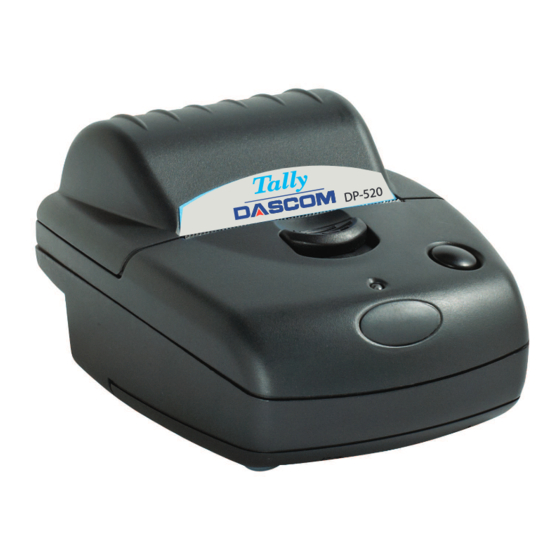Dascom DP-520 Посібник оператора - Сторінка 18
Переглянути онлайн або завантажити pdf Посібник оператора для Принтер Dascom DP-520. Dascom DP-520 19 сторінок. Wired printer
Також для Dascom DP-520: Посібник користувача (12 сторінок), Швидкі інструкції з налаштування (2 сторінок), Швидкі інструкції з налаштування (2 сторінок)

You may find that you can connect the printer to your Personal Computer (PC), and everything works perfectly the
first time. However, there are many variables, and the following guide may help if you find you need some
assistance. These are only suggestions, and may not work with all PC's.
Connecting to a PC – A Checklist
First, MAKE SURE THE PRINTER IS OPERATIONAL
Make sure that the battery pack is connected. Remember that operation from the charger alone is not possible: a
battery pack must always be installed. Also remember that battery packs are normally supplied disconnected
and discharged. They should be connected and then fully charged before use (e.g. trickle charged for at least
15 hours).
Wake the printer up by pressing the Paper Feed button once and releasing it. The Status Indicator should light; if it
does not, the battery may be discharged (or not connected correctly): connect the charger, and the status indicator
will come on.
When the printer is awake, load paper and then press the feed button to check that paper feeds. Press the paper feed
button again twice in quick succession (like double-clicking a PC mouse) and the printer should print a self-test
message. This will show that the printer is operational, and also reports how the printer's serial data interface is
configured.
Next, CONNECT THE PRINTER TO THE PC
The back panel of a PC typically includes several D-type (keystone-shaped) connectors. One of these is usually:
DB-9 Plug (male):
You can use any available serial port for the printer. COM1: is assumed in what follows, as most likely to be
available.
You will need a suitable cable. Use either a standard cable from Dascom (see Section 'Combined Data/Charger
Adaptor Cable'), or make up your own using the information in the same section.
Now you will need to SET UP YOUR COMPUTER'S SERIAL PORT to match the printer (it is also
possible to change the printer's settings, but not until you have established communication with the computer).
Your proposed application program may have a way of doing this, or you can get to the DOS prompt [e.g. C:\>] and
type the following command line (assuming you have connected the printer to COM1:):
MODE COM1:9600,N,8,2 [RETURN]
This will set up the port (COM1:) to 9600 baud, No parity, 8 data bits, and 2 stop bits which is the default setting for
the printer.
Now, SEND SOME DATA TO THE PRINTER from your computer. An easy way to do this from the DOS
prompt is to type:
DIR >COM1: [RETURN]
This should send a directory listing to the printer. The lines will probably overflow, but it will at least show that the
communication between the computer and the printer is working.
Alternatively, in Windows, use the TERMINAL program to send some text to the printer.
™
Windows
Printer Drivers
14
Getting Started
COM1: Serial port for mouse, modem, serial printer, etc
